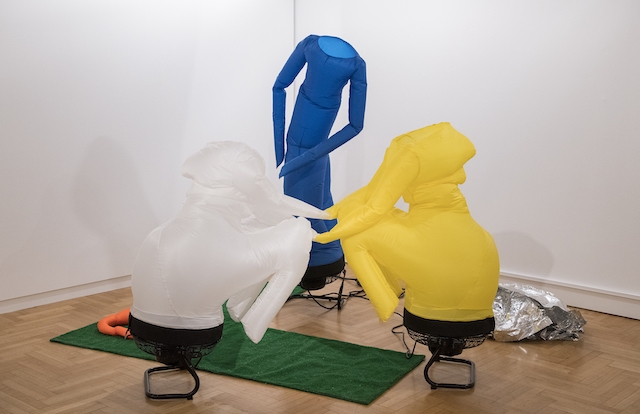Unlike other Ancient Greek heroes, Odysseus is renowned not for his courage or physical prowess but his hoodwinking and chicanery. In the Odyssey these questionable qualities coalesce around the word polytropos, which translator Stephen Mitchell renders as ‘infinitely cunning’. Paul Chan identifies closely with Homer’s wily protagonist, and in particular polytropos, suggesting in his Los Angeles Review of Books essay ‘Odysseus as Artist’ (2017) that cunning and adaptability are essential traits for artists, especially those attempting to influence social change. It’s an eccentric metaphor but one that seems apropos in Athens, where it underpins Chan’s handsome exhibition at the Museum of Cycladic Art, presented by the city’s NEON foundation and guest-curated by Nottingham Contemporary’s Sam Thorne.
Populating the museum’s modest ground-floor galleries are the American artist’s kinetic ‘breather’ sculptures – tubular nylon figures that flail and jerk as air from modified industrial fans fill their bodies. There are versions here of Odysseus, his wife, Penelope, and son, Telemachus. Like less-frenzied versions of the spasmodic ‘sky dancers’ seen at car dealerships, they gently animate the low-ceilinged spaces. For this exhibition Chan has recast them as ‘bathers’, resurrecting a familiar art-historical trope against a backdrop of anxieties regarding the European migrant crisis. This is most overt in Les Baigneurs (suitors as fugees as suitors) (all works 2018), where a gangling blue ‘bather’ stands alongside two more figures that sit holding hands. While its title alludes to the suitors that invade Penelope’s home in the Odyssey, a foil emergency blanket and orange life preserver at the bathers’ feet evoke the recent horror of bodies washed ashore on Mediterranean beaches.
Prejudice against migrants, refugees and, indeed, anyone identified as ‘other’ is more subtly addressed by Chan’s vibrant towel paintings. These unstretched canvases draped over domestic towel rails are daubed straight from the tube with colourful forms echoing those of his squirming sculptures. Reminiscent of Matisse’s cut-outs, the slapdash paintings are intended as an indictment of the politics of suspicion currently dividing Chan’s native US (significantly, none of the shapes touch or integrate). Hard-hitting, politically charged works defined the artist’s early career, but these appear surprisingly tentative. Conversely, the show’s most salient moment is La Baigneur 7 (Teenyelemachus), a convulsing, wraithlike figure surrounded by concrete-filled shoes connected with suicide cables. Conceivably an emo version of Telemachus, the gasping jet-black character more closely recalls the Grim Reaper, serving as a metaphor for a death-wish culture choking on its own hubris.
While Chan’s theories surrounding polytropos are eloquently articulated in his writings, it’s hard to grasp how the notion of cunning as manifest in Odysseus actually applies to these sculptures and paintings. The answer seems as elusive as the precise meaning of that Ancient Greek word (‘resourceful’, ‘inventive’, ‘versatile’ and ‘many-turning’ being among the copious proposals). While Chan’s multilayered works likewise invite multiple readings, many share an underlying anxiety about art’s capacity to offer meaningful alternatives to current social reality. This is best exemplified by Poordysseus, the show’s final work, which transforms the Greek hero into a billowing yellow shapeshifter caught inside a glass vitrine. Here, Odysseus the cunning artist is rendered impotent, entrapped by the goddess Calypso’s carnal pleasures; his floundering frame perhaps admonishing contemporary artists correspondingly seduced by the market. With the exhibition culminating in a literal dead end, you exit by retracing your steps; it’s a truly cunning device whereby viewers experience the works twice. Sometimes the route to progress requires a renegotiation of the past.
Paul Chan: Odysseus and the Bathers, NEON at the Museum of Cycladic Art, Athens, 5 July – 14 October
From the September 2018 issue of ArtReview
